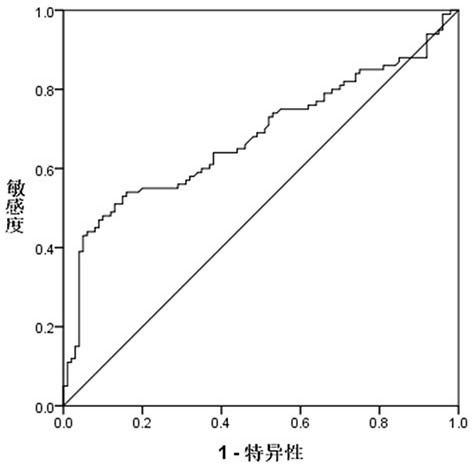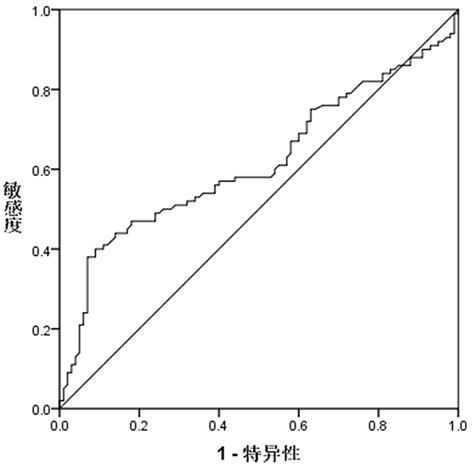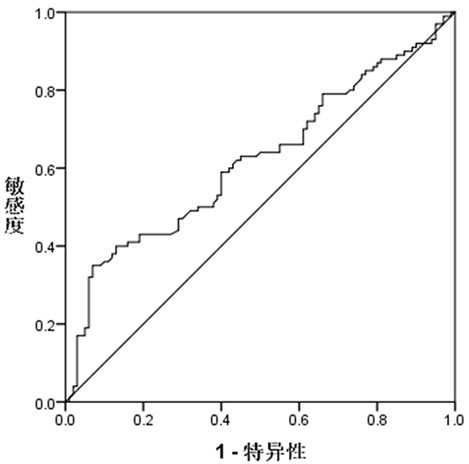Peripheral blood-based esophageal squamous carcinoma screening marker and kit
A technology of esophageal squamous cell carcinoma and markers, which is applied in the field of medicine and biology, can solve problems such as complex experimental steps, low sensitivity, and narrow detection dynamic range, and achieve good differentiation effect, high sensitivity and specificity, and good diagnostic effect
- Summary
- Abstract
- Description
- Claims
- Application Information
AI Technical Summary
Problems solved by technology
Method used
Image
Examples
Embodiment 1
[0038] Example 1: Screening of serum differential metabolic markers for esophageal squamous cell carcinoma
[0039] 1. Experimental samples
[0040] According to strict screening and exclusion criteria, 100 age- and sex-matched healthy subjects (normal control group) and 100 patients with esophageal squamous cell carcinoma (esophageal squamous cell carcinoma group) were collected from the First Affiliated Hospital of Zhengzhou University. The average age of 100 healthy subjects: 58.5 years old, ranging from 42-80 years old; the average age of 100 patients with esophageal squamous cell carcinoma: 59.5 years old, ranging from 42-83 years old.
[0041] The inclusion criteria for healthy subjects were: aged between 42 and 80 years old; no tumor was diagnosed by physical examination, no previous history of cancer; no other major systemic diseases; no chronic disease history of long-term medication.
[0042] The inclusion criteria for patients with esophageal squamous cell carcinom...
Embodiment 2
[0070] Example 2: Evaluation of the ability of differential metabolite diagnosis to distinguish patients with esophageal squamous cell carcinoma from healthy people
[0071] 1. The ability of a single differential metabolite diagnosis to distinguish patients with esophageal squamous cell carcinoma from normal people:
[0072] S-sulfo-L-cysteine in the esophageal squamous cell carcinoma group (100 patients with esophageal squamous cell carcinoma) and normal control group (100 healthy subjects) serum samples detected based on UPLC-Q / TOF-MS in Example 1 acid, symmetric dimethylarginine, and 4-methoxyphenylacetic acid content data were analyzed, and the receiver operating curve (ROC curve) was used to evaluate each differential metabolite to diagnose and distinguish patients with esophageal squamous cell carcinoma and normal human ability. The ROC curves of S-sulfo-L-cysteine, symmetrical dimethylarginine, and 4-methoxyphenylacetic acid in differentiating patients with esophage...
Embodiment 3
[0096] Example 3: Application of three differential metabolites in the screening of esophageal squamous cell carcinoma
[0097] 1. Collection of serum samples
[0098] According to strict screening and exclusion criteria, 50 age- and gender-matched healthy subjects (normal control group) and 50 patients with esophageal squamous cell carcinoma (esophageal squamous cell carcinoma group) were collected from the First Affiliated Hospital of Zhengzhou University.
[0099] The inclusion criteria for healthy subjects were: aged between 42 and 80 years old; no tumor was diagnosed by physical examination, no previous history of cancer; no other major systemic diseases; no chronic disease history of long-term medication.
[0100] The inclusion criteria for patients with esophageal squamous cell carcinoma were: aged between 42 and 83 years old; patients with esophageal squamous cell carcinoma confirmed by endoscopy and histopathology, who had not received radiotherapy or chemotherapy; no...
PUM
 Login to View More
Login to View More Abstract
Description
Claims
Application Information
 Login to View More
Login to View More - R&D
- Intellectual Property
- Life Sciences
- Materials
- Tech Scout
- Unparalleled Data Quality
- Higher Quality Content
- 60% Fewer Hallucinations
Browse by: Latest US Patents, China's latest patents, Technical Efficacy Thesaurus, Application Domain, Technology Topic, Popular Technical Reports.
© 2025 PatSnap. All rights reserved.Legal|Privacy policy|Modern Slavery Act Transparency Statement|Sitemap|About US| Contact US: help@patsnap.com



